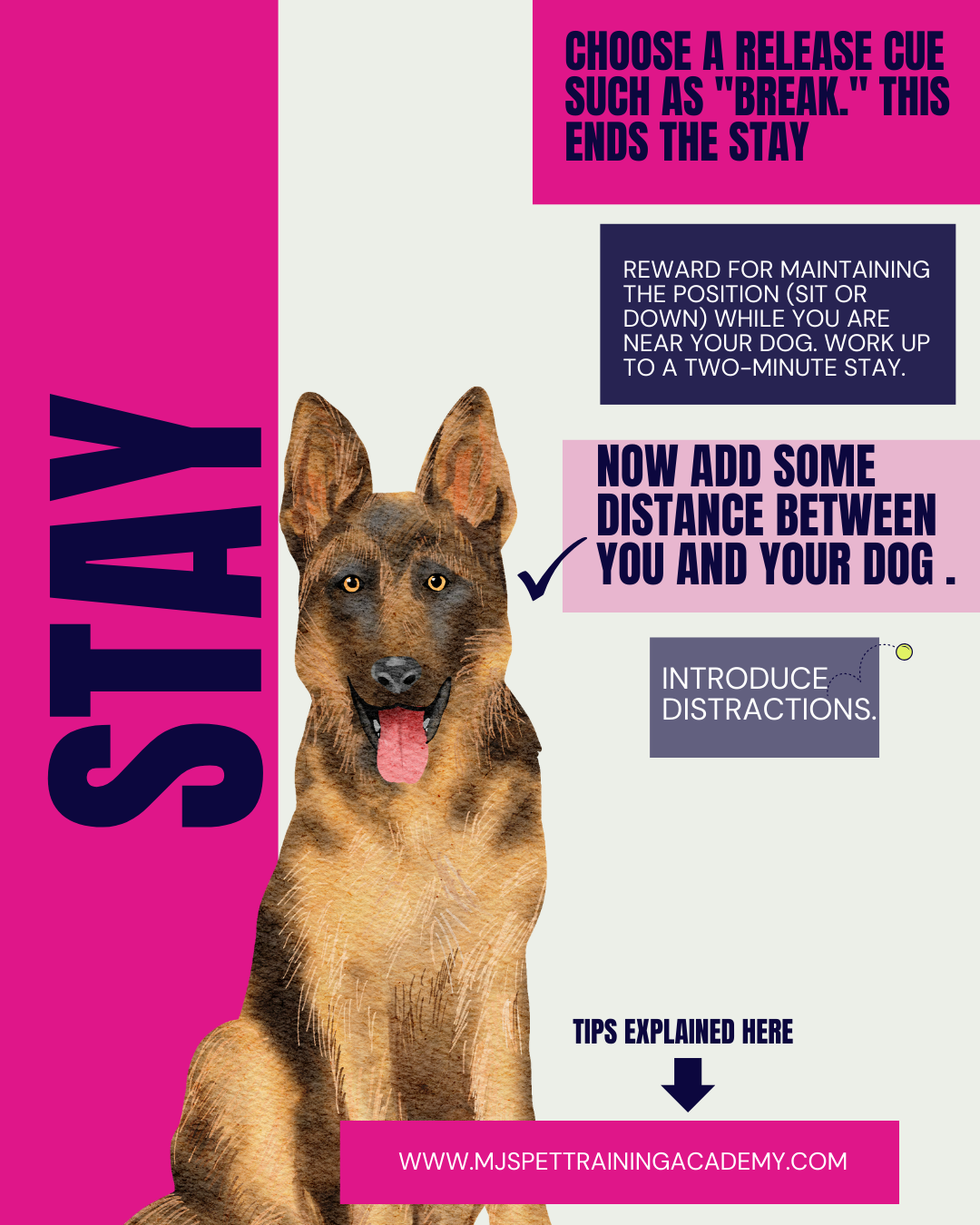How to Train a Reliable Stay
How to Train a Reliable Stay
Is your dog struggling with breaking the stay command when distractions arise? Teaching a solid stay isn’t just about getting your dog to sit still—it’s about building focus, patience, and reliability in everyday life.
⭐ Top Tip for Stay Training
Stay means stay — until you say otherwise. Use a consistent release cue like “Break” to teach clarity and avoid confusion.
→ Need Help? Book a Private LessonMany dog owners find stay tricky to teach, but with the right approach, you can help your dog understand how to hold a position until released, even in busy environments. Whether you’re training a new puppy or fine-tuning an older dog’s skills, this guide will help you build a strong, reliable stay.
Why Stay Matters
A well-trained stay can make life easier in many ways. You can use it to:
Keep your dog from rushing the door when guests arrive
Maintain control in busy environments like sidewalks or pet-friendly stores
Capture great photos without your dog breaking position
Build impulse control for advanced training or everyday life
The key to success is making sure your dog understands when the stay is over—and that it’s worth their while to wait. If you tell your dog to sit, how does your dog know when to get up? Clarity is key. You are not just training your dog, you are creating a set of rules between you and your dog. It is important to think about the skills you train and what they mean. Does sit mean sit until you walk away or a distraction occurs? I sure hope not! If your dog has learned to sit only for a second without any clear signal that ends the sit, you are going to run into problems as you start training the stay.
Training for Duration
Learning how to train skills that require some duration can make you a better trainer. I’m not just talking about sit and down. The skills you train your dog will either have a clear start and end, or require you to tell your dog when the skill is complete. You might train your dog to spin in a circle. After one circle, the trick is over. You don’t need to tell your dog to stop spinning. But, if you train your dog to step up onto a platform, how does your dog know when to step off?
I challenge you to train a variety of skills which require some duration. Anyone can train a nose target for example, but can you train your dog a nose target with duration which your dog olds until released? How about holding a dog training dumbbell until you give the release cue, or holding one paw on an object?
You might think you don’t need any of these “tricks,” but it’s not about training fancy tricks, it’s about challenging your training skills, improving your microskills and becoming a better trainer. You will be amazed what your dog can do. All of these additional challenges will contribute to stronger obedience, too.
1. Start Small
Let’s start with some more obvious skills for training the stay. Choose sit or down and use “break,” to end the stay. You can replace this cue with your own.
Ask your dog to sit or down
Reinforce the position by feeding in place. If you are using this technique your dog should still be in the position while accepting the treat. The other technique is to delay reinforcement. Either works! The key is making sure your dog stays until you end it.
Say “break” (or another release cue) and encourage your dog to move
Repeat so your dog learns the difference between staying and being released
2. Build Duration
Once your dog understands the concept of waiting for the release, start increasing how long they can hold the stay.
Gradually add a few more seconds before releasing
Reward at random intervals while they stay
Work up to a minute, then two, then three
One technique I like at this stage is reinforcing eye contact while the dog holds position instead of looking at the treats in your hand or pocket. You can use some regular kibble and calmly deliver a piece of food to your dog every time your dog gives eye contact while in the stay position.
Hint: If you ask for a sit, your dog should remain in the sit. If you ask for a down, your dog should remain in the down.
3. Add Distance
When your dog can stay for longer periods, begin adding distance.
Step away briefly, then return and release
At first, distance might involve standing up away from your dog as your dog stays. Start wherever you need to.
Slowly increase how far you go.
Work toward turning away, walking around, and even leaving the room when your dog is ready.
If your dog is used to eye contact from previous steps, don’t worry. Your dog will learn to offer eye contact as you return. You can still work up to stepping away and even walking out of the room. Your dog will learn that eye contact is for when you are in front and as you turn away holding the stay is still the expectation as you break eye contact.
4. Introduce Distractions
Dogs often struggle with stay when real-world distractions come into play. Some ways to challenge your dog’s stay include:
Dropping a treat on the floor
Rolling or bouncing a ball nearby
Practicing while another dog walks past
One exercise I like for advanced training is rolling a ball under dogs in a stand stay or bouncing a ball over dogs in a down stay. A well-trained dog isn’t staying out of fear of correction—they’re staying because they understand the behavior. You can see this in the dog’s body language. We play games in our advanced classes that involve bouncing a ball over dogs and more. The dogs conquer these challenges and have been trained through patience, play, and positive reinforcement.
5. Train in Different Locations
It’s important to practice stay in a variety of places.
Try different rooms in your house
Practice at the park, on the sidewalk, and in pet-friendly stores
Work on stay with new distractions like kids playing or other dogs walking by
The more you challenge your dog in different environments, the stronger their stay will be.
6. More Ways to Stay
Remember, stay is not just for sit and down. You can train your dog to stand-stay easily with a bit of practice. In AKC Obedience the stand for exam is an exercise dogs must know to compete in trials.
You can also work the stay into your dog’s Trickovation and fitness routines. I like to work on a variety of paws up behaviors with my dogs, turning regular walks into agility-like challenges. You can have your dog stand tall with his front paws on a tree until you say break for example.
If you want a pro-level challenge, train your dog a nose target with duration. This can be a challenge to train.
Hint: Your dog should not jump up onto anything without a cue. You don’t want your dog randomly jumping on things.
Need Help with Training?
If your dog struggles with holding a stay, gets distracted easily, or needs more structured training, working with a professional trainer can speed up progress.
Private lessons provide one-on-one guidance and troubleshooting.
Group classes offer structured training with built-in distractions.
Puppy training programs help young dogs develop impulse control from the start.
A well-trained stay isn’t just about obedience—it’s about creating a dog that is calm, focused, and reliable no matter where you go. If you need help refining your dog’s stay or building better manners, reach out for a training session.
I’d love to hear what your dog’s biggest stay challenge or accomplishment is—let me know what you’re working on!

